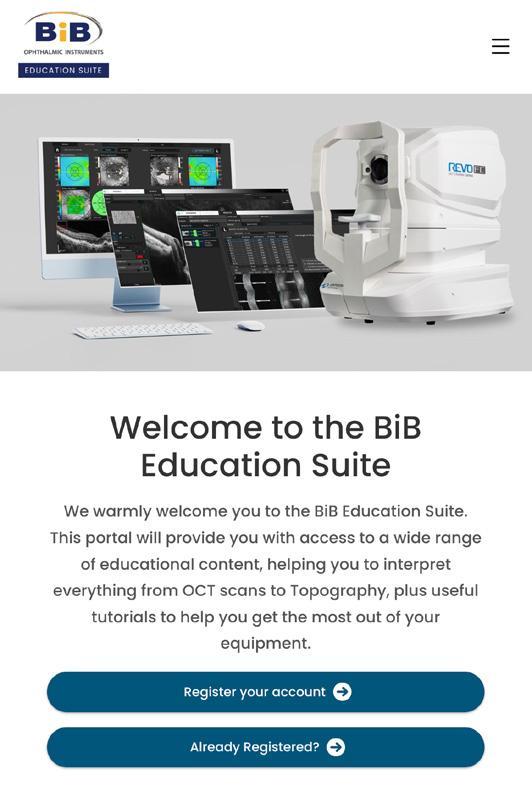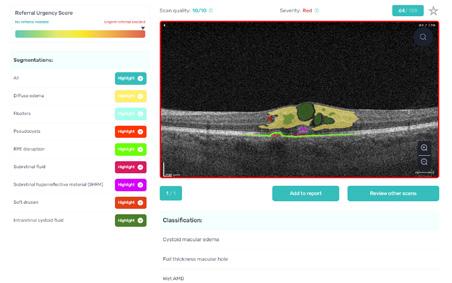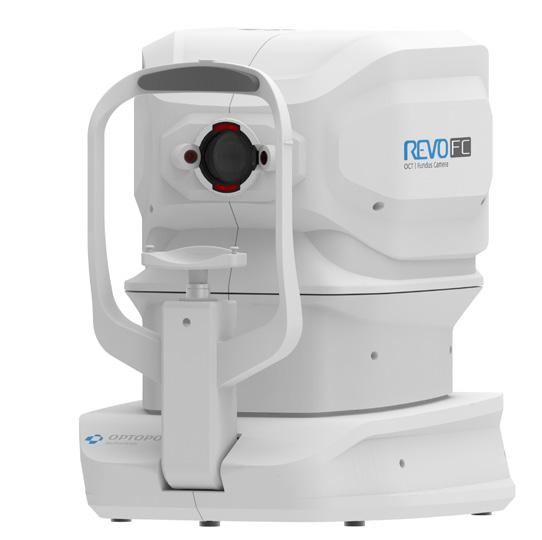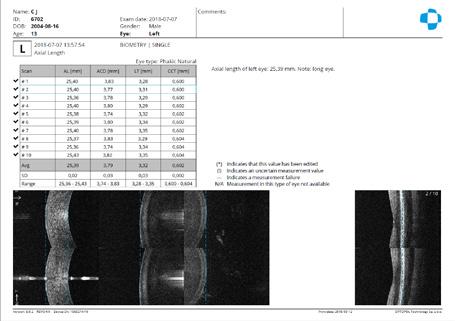
6 minute read
Support through education and innovation
by Vision Now
E-LEARNING AND PEER SUPPORT
The BIB Education Suite – which can be found at https://bib.education – is the company’s new e-learning site. “We set up this new e-learning platform to help address the need for ongoing education and support,” says Tim Baker, CEO of BIB Ophthalmic Instruments. “Here customers will find both user training and guides on interpreting results on products such as OCT [optical coherence tomography], perimetry and corneal topography to help our customers get the most from their investment.”
NEG members who are considering investing in any of BIB’s technologies – or who are existing users – can simply log in and register their details. “We will then gladly provide full access to the e-learning zone,” explains Tim.
“OCT interpretation of scans covers some of the most commonly found and recognised pathologies – with narration kindly provided by optometrist and dispensing optician, Jason Higginbotham. Jason is also about to complete interpretation of visual field results, which will be uploaded on to the site very shortly.”
BIB plans to expand its e-learning facilities to include CPD-accredited lectures and further general training and interpreational videos. Other educational activities planned for later this year include a series of CPDaccredited webinars hosted by Perceptive and run by Peter Charlesworth and his team. There will also be a series of roadshows offering CPD-accredited lectures and workshops at four major regional sites. Practitioners looking for advice and assistance from peers and fellow OCT users can register with OCTForum.com at https:// octforum.com/register. Explaining more about the forum, Tim says: “OCTForum allows members to post questions, whilst following GDPR regulations, which fellow members can answer – providing peer advice and support. Users will also find educational and news posts, updated regularly, as well as upcoming CPD content.
“Our educational content, OCTForum and Altris AI [see later] can remove the worry around getting used to an OCT if you’ve not used one previously,” continues Tim. “OCT is a ‘game changer’ in daily optometric practice and our resources speed up the process of familiarising yourself with the software – and with the interpretation of many common lesions. This takes away the fear and allows the practitioner to enjoy the improvements that OCT can make to their daily practice.”
Managing Myopia With Oct Biometry
At 100% Optical in February, myopia management was one of the hottest topics discussed and the subject of an open debate with key opinion leaders on the main stage.
“It is now widely accepted that being able to record and monitor axial length changes is not only a vital tool in myopia management, but it can be used as a visual education and sales tool for parents,” says Tim. “This facilitates a better understanding of the issue whilst demonstrating the positive effects of dispensing myopia control lenses and contact lenses. There is now a shift in attitude towards myopia, which all optometrists and practice owners need to be aware of.”
Jason Higginbotham, who is CEO of FYEye, owner of OCTforum.com and managing editor of myopiafocus.org, says:
“The World Council of Optometry has clearly stated that myopia should no longer merely be considered a refractive error. It is, in fact, a potentially sight-threatening eye condition. We also know that, despite genetic causes being identified, the vast numbers of myopia sufferers cannot be explained by genes alone. Lifestyle plays a huge part in its development. Simply conducting eye examinations on children without screening for myopia or discussing the risks with parents is not acceptable.”
As Tim points out, the College of Optometrists’ recent guidance attests to Jason’s point. He says: “If you already own a Revo OCT, we can easily help you to measure the most important parameter in myopia management – axial length. Many key opinion leaders say that without axial length, there could be some patients who do not receive the fullest level of attention they deserve.
“Many of the specific devices on the market for myopia management are costly, and they take up a lot of room,” continues Tim. “Adding the biometry module to your OCT will give much of the clinical performance you need for myopia management. You can then use online calculators from the Brien Holden Vision Institute to better predict future axial length without treatment, and then plan therapies to ‘flatten the curve’ and reduce future risk of sight impairment. You won’t need to make a large investment or take up valuable space in your practice either.”
It is widely held that one of the most effective treatments for myopia is orthokeratology (ortho-k). “As we know, these rigid gas permeable ‘night lenses’ reshape the cornea during sleep so that many patients are spectacle and contact lens free during the day,” says Tim. “Apart from this obvious benefit for confidence when playing sports and getting outdoor time, it is highly effective at producing myopic peripheral defocus, leading to the slowing down of myopia progression. If you intend to offer ortho-k, you won’t be able to use the prescription as a measure of progression and so axial length measurement is most important in these cases.”
Another advantage of the biometry on the Revo OCT, Tim explains, is that it provides all parameters, not just axial length, so corneal centre thickness, anterior chamber depth, lens thickness and vitreous chamber depth. “Local companies that offer cataract procedures on behalf of the NHS may be interested to know you have this functionality available,” Tim suggests.
“The topography module allows for a detailed understanding of the central corneal thickness, corneal epithelial thickness and, of course, central curvature analysis. This will allow those wishing to get involved in local keratoconus screening schemes to do so without having to invest in a separate topographer.”


OCT-A: ANGIOGRAPHY
Another increasingly popular module for the Revo OCT is OCT-A (angiography).
“This allows for a better understanding of the vascular health of the retina and choroid,” explains Tim. “One of the most frequently conducted test in macula clinics after referral for suspected choroidal neovascularisation [CNV] is fluorescein angiography and indo cyanine green angiography. Optometrists cannot undertake these very useful procedures, but OCT-A allows practitioners to view similar results in a non-dynamic way.
“This can profoundly alter the way you manage, monitor or refer many age-related macular degeneration [AMD], diabetic or other retinal pathology patients. For instance, there are examples where what appears to be later stage dry AMD has already transformed into a wet AMD and this may not be obvious on the colour fundus, OCT B-Scan or from the patient’s signs and symptoms. OCT-A can quickly identify CNV, for example, and this will change the referral pathway and urgency and could save the patient’s sight.”
Tim adds: “OCT is becoming so much more versatile and you can use it for so many other elements of daily practice without taking up more space in your clinic. You can save time and money by making the fullest use of the resources at your disposal on the Revo OCT. And, of course, NEG members can enjoy OCT biometry, topography and OCT-A at a specially reduced rate when purchasing any Revo OCT.”
Ai Diagnostics In The Cloud
BIB is working closely with Altris AI, which provides a subscription-based artificial intelligence (AI) diagnostic platform. Practitioners can upload OCT scans to Altris AI’s cloud-based AI solution and in around one minute, will receive a severity analysis on the segmentation of macula scan, plus classification of any pathologies to support the diagnosis.
The AI model has been developed over six years and is trained on more than five million b-scans for highly accurate results. The benefits include: the provision of efficient OCT scan analysis backed up by AI diagnosis support; no minor, rare or early pathologies missed due to severity detection; accurate segmentation and classification mean no follow up visit is ignored; less time spent on reading nonpathological scans, leaving more time to focus on other clinical areas and ultimately remove any doubts by relying on proven algorithms.
“The Altris cloud-based AI platform can help less experienced optometrists to gain confidence in offering OCT within their practice,” says Tim.
The scan type needs to be in a ‘DICOM Tomogram series format’. The scans are then uploaded to the Altris AI platform. “Initially, the raw scans were of such a size that the upload/download time was far from acceptable,” reveals Tim.

“However, utilising the set-up parameters within Optopol’s software, we have now managed to compress the size of the raw scans from 450MB to only 15MB without losing vital detail. In turn, this has speeded up the upload time and the time to receive the final diagnosis to around only one minute, dependent of course on local available internet speed. In addition, a specific file location for uploading scans has been created within the Optopol software to further simplify and streamline the process.”
The system is fully GDPR compliant, with encrypted data that can’t be reached by any third party. All patients’ critical data is tokenised and protected from disclosure at all stages. “Data storage formats can be saved, and it can be easily integrated into any practice management system or work separately as a web application,” adds Tim. ■
Until further notice, BIB is offering NEG members a free subscription period with Altris AI when purchasing any Optopol OCT. And don't forget: NEG members also enjoy OCT biometry, topography and OCT-A at a specially reduced rate when purchasing any Revo OCT. For further information on all sales and educational matters, contact BIB on 01438 740823.








